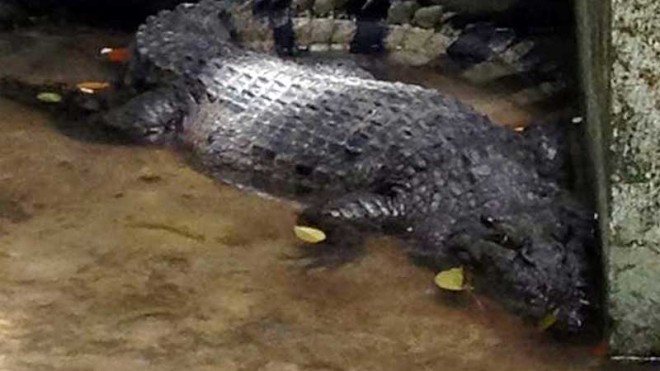
LARGEST FRESHWATER CROC “Malang,” a Philippine freshwater crocodile caught by fishermen in M’lang,North Cotabato province, is believed the largest of its kind in captivity. WILLIAMOR A. MAGBANUA/INQUIRER MINDANAO
M’LANG, North Cotabato—It’s only a third of the late Lolong’s size, but the catch has nevertheless caused excitement in the Liguasan Marsh.
Fishermen from Barangay Dungguan claimed that the freshwater crocodile they caught on April 12 could be the largest so far captured. The reptile has been named “Malang.”
Ali Hadji Nasser, chief of the Protected Areas and Wildlife Division (PAWD) of the Department of Environment and Natural Resources in Central Mindanao, said that prior to this, the largest in captivity among Crocodylus mindorensis (Philippine freshwater crocodile) was just 1.65 meters. It was caught in the Agusan Marsh a few years back.
Nasser said the one captured by the M’lang fishermen officially measured 2.18 meters. “Our main office in Manila confirmed that it was the largest so far,” he said.
Philippine crocodiles grow to a maximum of 3.05 m, according to wildlife journals.
Another environment official said that while the M’lang catch was the largest so far, it was possible that larger ones lurk in the Liguasan Marsh.
Mamutur Cariga of the Kidapawan City Environment and Natural Resources Office pointed out that the 220,000-hectare marshland, which straddles the provinces of Maguindanao, North Cotabato and Sultan Kudarat, is conducive to wildlife.
“It is not remote that the marsh, due to its vastness and absence of active human inhabitants, hosts huge crocodiles,” he said.
Saltwater crocs
Cariga said there was also a possibility that “saltwater crocodiles” even bigger than Lolong thrive in the marshland, which draws water from the Pulangi, Maganoy, Buluan and Allah rivers.
Lolong was a 6.09-m saltwater crocodile (Crocodylus porosus) caught in Agusan del Sur province in 2011. Lolong died last year.
Nasser said the PAWD had allowed the local government of M’lang to take custody of the freshwater crocodile caught last week until its release back to the wild.
“As we have seen, the LGU (local goverment unit) is doing everything to protect it and is also financially capable to spend for its food,” he said. Crocodiles normally eat birds and small animals.
Nasser also warned residents against hunting crocodiles, which are considered endangered wildlife.
Under Republic Act No. 9147, or the Wildlife Resources Conservation and Protection Act, anyone found to be in custody of crocodiles will be imprisoned for up to 12 years and pay a fine of P1 million. Williamor Magbanua and Edwin Fernandez, Inquirer Mindanao